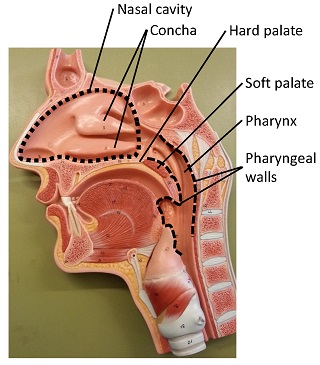Modeling of Obstructive Sleep Apnea by Fluid-Structure Interaction in the Upper Airways
Introduction
Snoring is caused by the soft parts of the upper airways collapsing and preventing the air from flowing freely. In some cases snoring is so severe that medical attention is required. The most severe, obstructive sleep apnea syndrome (OSAS), affects 2-4 percent of the population. The syndrome is recognized by heavy snoring, frequent breathing stops, gasping for breath, and awakenings. OSAS is the cause for low quality sleep and reduced oxygen consumption and is considered as a major cause for reduced life quality and increased mortality in the modern society. There are a variety of available treatment options for OSAS, but today there are no available methods for predicting the outcome of the treatment. There is a demand for treating OSAS in a more targeted way to allow for more predictable results and improved probability for choosing a successful form of therapy.
Key to predicting the outcome of the treatment is to fully understand the physical mechanisms behind OSAS. That is, we need improved understanding of the airflow in the upper airways and of the airway features and properties responsible for the syndrome. To achieve this, mathematical models play a crucial role. The current project will focus on developing mathematical models for the interaction between the airflow and the soft tissue in the upper airways. The models will be employed to analyze patient specific cases to reveal the secrets behind successful OSAS remedy. In the future, the mathematical models can be part of a tool that can be utilized by medical personnel in the planning stage of OSAS treatment. Imagine for instance that a computer can give advice on the optimal way to solve the patient's problems based on CT- and MRI scans. Thus, the physician's assessment can be supplemented by objective recommendations, and the patient is guaranteed the best cure available.
Objectives
The objective of the proposed research project is to develop a clinical tool to predict the response of surgeries for Obstructive Sleep Apnea Syndrome (OSAS) patients and to identify the decisive pathophysiological mechanisms for the development of OSAS.
The goal is to demonstrate the potential of a new patient-specific clinical tool to predict the response of OSAS surgeries and to find risk conditions for the obstruction of the upper airways during sleep by modeling the interaction of the inhaled air flow from nose and mouth with the soft palate and the interaction of the flow with the tissue in the velopharynx. The long term goal is to improve the diagnosis and treatment effectiveness of the syndrome by predicting the site and extent of airway collapse, and the subsequent change of these parameters from the therapy chosen.
Summary
The project aims at the heart of the Norwegian national strategy for biotechnology, by bridging the current gap between a major health issue in the population and technologically based diagnostics and decision making for medical personnel. Obstructive Sleep Apnea Syndrome (OSAS) is caused by repetitive collapses of the pharyngeal walls during sleep resulting in oxygen desaturation and sleep disturbances. OSAS has a huge impact on global health; it is related to a range of modern society diseases. 4% and 2% of the male and female population, respectively, and 2-3% of children suffer from OSAS.
The treatment options for the conditions remain obscure, with surgery being one option. No accepted guidelines exist, however, on what type of nasal surgery to perform or in which subgroup of patients a positive outcome can be predicted. From a clinical point of view we need a new way of looking at the underlying mechanisms of OSAS, and there is a demand for treating OSAS in a more targeted way, to allow for a more predictable outcome of the treatment and improved chances of positive response to the treatment. The proposed project will demonstrate a new clinical tool to predict the response to OSAS surgery. The main hypothesis of the project is that by employing a combination of clinical examination and computer model investigation of fluid-structure interaction in the human upper airways, it is possible to evaluate the effect of surgery with respect to OSAS mitigation. Ultimately, the research activity will result in a tool that can be utilized by medical personnel in the planning stage of OSAS treatment.
The project is multidisciplinary by nature and is organized in four work packages; clinical research; soft tissue modeling; mathematical modeling of fluid-structure interactions; and CFD modeling for prediction of the success of OSAS surgery. The main deliverable of the project is a method to perform patient specific cause-and-effect studies with respect to OSAS mitigation.
Funding
The research project "Modeling of Obstructive Sleep Apnea by Fluid-Structure Interaction in the Upper Airways" has been funded by the Research Council of Norway under project number 231741 since mid 2014. The funding for 50 % of two PhD students has come from St. Olavs Hospital and the Faculty of Engineering Science and Technology of the Norwegian University of Science and Technology (NTNU). The supervision of the three PhD students in the research project has been funded by NTNU.
